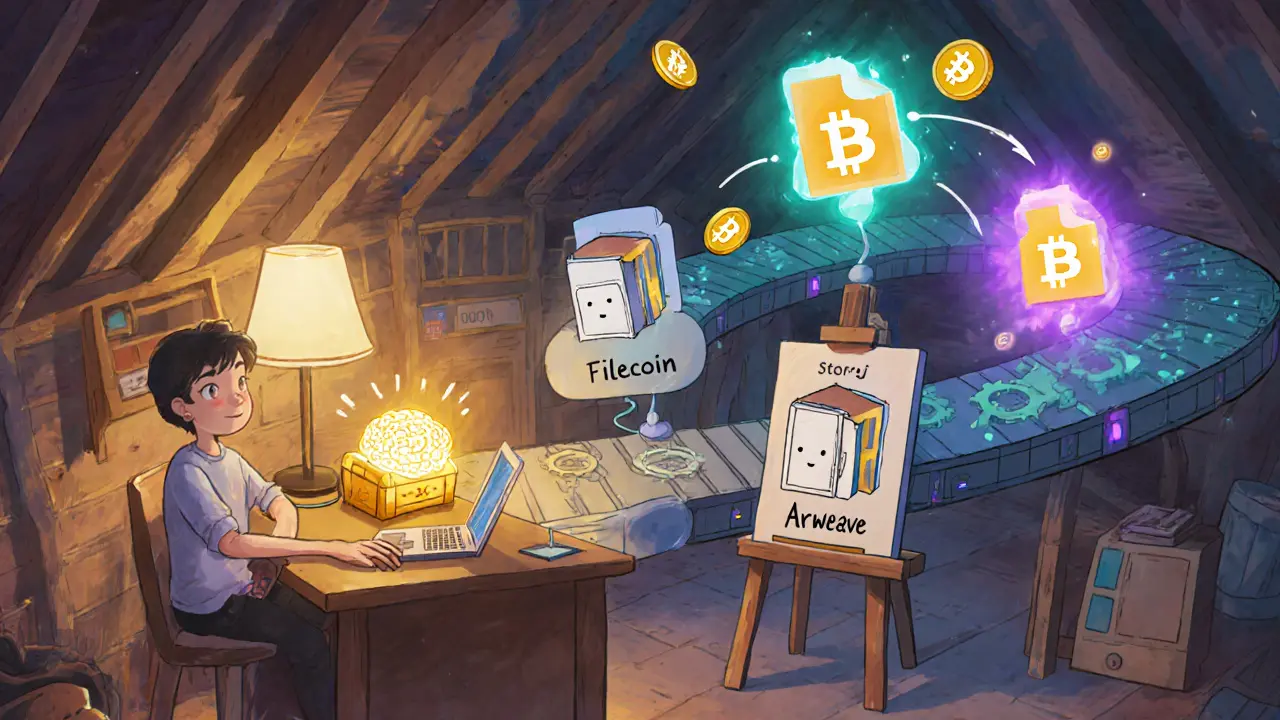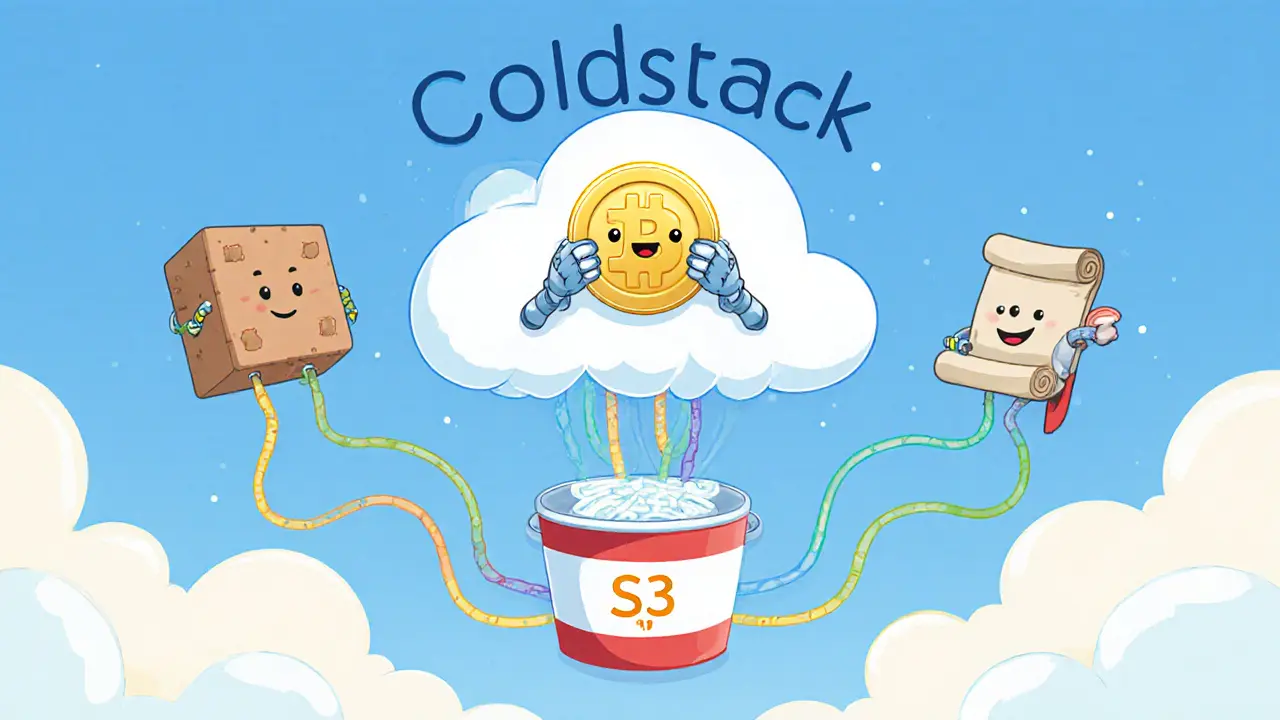Coldstack (CLS) Token Value Calculator
About Coldstack (CLS)
CLS is an ERC-20 token that powers Coldstack's decentralized cloud aggregation platform. This calculator helps estimate the value of your CLS holdings based on current market data.
Tokenomics Overview
Total Supply: 50,000,000 CLS
Foundation Reserve: 70% (35,000,000 CLS)
Circulating Supply: ~18,000,000 CLS
Current Market Cap: ~$261,000 (at $0.0145)
Your CLS Investment Value
$0.00
Based on current price of $0.0145 per CLS
Important Notes:
- Price volatility is significant; values may change rapidly
- 70% of tokens are held by the foundation, affecting liquidity
- Market sentiment is currently bearish
- Value calculation does not account for gas fees or transaction costs
When people talk about decentralized storage, Coldstack (CLS) is an ERC‑20 utility token that powers a cloud‑aggregator platform. The service promises to bundle several blockchain‑based storage networks-like Filecoin, Storj and Arweave-behind a single Amazon S3‑compatible API.
Quick Summary
- Coldstack (CLS) is an ERC‑20 token that lets users pay for storage across multiple decentralized networks.
- The platform uses an AI‑based optimization pipeline to pick the cheapest, fastest network for each file.
- Tokenomics: 50million total supply, 70% held by the foundation, current price ~$0.0145.
- Unique selling point: a single S3‑compatible endpoint that works with Filecoin, Storj, Arweave and even NFT minting (ERC‑721 & ERC‑1155).
- Market reality: price down ~97% from ICO, low daily volume, bearish sentiment as of Oct2025.
What Coldstack Actually Is
Coldstack positions itself as a “decentralized cloud aggregator.” In plain English, instead of you having to pick one of the three big storage blockchains, Coldstack lets you upload a file once, then silently routes the data to the network that offers the best price‑performance combo. The routing decision is driven by a proprietary AI‑based optimization pipeline that looks at file size, type and user‑defined preferences.
The platform’s front‑end is built around the Amazon S3 API. That means any software that already talks to Amazon S3 (most cloud‑backup tools, web apps, and even desktop clients) can point at Coldstack without any code changes. This S3 compatibility is the main hook for developers and businesses that want to dip their toes into decentralized storage without learning new protocols.
How the CLS Token Works
The CLS token is an ERC‑20 utility token on Ethereum. Every storage operation-upload, retrieval, or even NFT minting-requires CLS as payment. The token’s economics look like this:
- Total supply: 50million CLS
- Foundation reserve: 70% (35M)
- Team allocation: 10% (5M)
- Seed sale: 12% (6M)
- Private sale: 8% (4M)
- Public sale: 1% (0.5M)
Only about 18million tokens are circulating, which means a large chunk is still locked in the foundation’s wallet. This concentration raises questions about price manipulation and liquidity, especially since daily trading volume hovers around $22k.
Technical Architecture at a Glance
The backbone of Coldstack is three‑layered:
- Unified API Layer: Exposes the Amazon S3 interface, handling authentication, bucket creation, and object lifecycle.
- Optimization Engine: The AI pipeline evaluates cost, latency and redundancy requirements, then selects Filecoin, Storj or Arweave for the actual storage.
- Blockchain Settlement Layer: CLS tokens are locked, spent and burned on the Ethereum mainnet to settle the storage contract.
Because each underlying network has different guarantees-Filecoin offers cheap bulk storage, Storj shines for high‑resolution images, and Arweave preserves immutable web pages-Coldstack’s engine can match the right tool to the right job without user intervention.
Why the Amazon S3 Compatibility Matters
Most enterprises already have S3‑compatible tools in place (AWS CLI, Cyberduck, custom SDKs). Switching to Coldstack only requires swapping the endpoint URL and adding a small amount of CLS to the wallet. No need to rewrite upload scripts, no need to learn new cloud‑provider SDKs. This lowers the barrier to entry dramatically compared with using Filecoin or Storj directly, where developers must learn new APIs and handle token payments for each operation.

Coldstack’s NFT Feature
Beyond plain file storage, Coldstack lets you mint NFTs directly from uploaded assets. It supports both ERC‑721 (single‑item) and ERC‑1155 (batch) standards. Artists can upload a high‑resolution piece, let the AI pick Storj for speed, and then create an NFT that references the stored hash. The NFT metadata lives on Arweave for permanence, while the visual file lives on Storj-a clean example of multi‑network synergy.
Market Performance and Price Outlook
Coldstack’s price story is a textbook case of hype followed by correction:
- ICO price (May2021): $0.5000 per CLS
- All‑time high (Feb2022): $1.12 (more than double the ICO price)
- Current price (Oct2025): $0.0145
- Decline from ICO: ~97%
The 50‑day SMA sits at $0.0198 and the 200‑day SMA at $0.0261, both well above today’s price, hinting at continued downward pressure. Sentiment on major analytics sites is “Bearish,” with a Fear & Greed Index of 51 (neutral). Unless Coldstack lands a major partnership or demonstrates clear cost savings over direct storage, the token likely stays in the low‑cent range.
Comparison with Direct Decentralized Storage Options
| Feature | Coldstack (CLS) | Filecoin | Storj | Arweave |
|---|---|---|---|---|
| Payment Token | CLS (ERC‑20) | FIL | STORJ | AR |
| API Interface | Amazon S3 compatible | Custom RPC/CLI | S3‑compatible (limited) | REST API |
| Best Use‑Case | Multi‑network storage, NFT minting | Large bulk data, archival | High‑resolution media, CDN‑like | Immutable web pages, permanent archives |
| Price Transparency | AI‑driven, per‑file cost shown before upload | Variable, market‑driven | Fixed per‑GB/month | One‑time fee per byte |
| Token Concentration | 70% foundation reserve | Distributed mining | Distributed staking | Distributed mining |
The table shows why some users prefer Coldstack: you get one click, one token, and the platform handles the rest. The trade‑off is reliance on the CLS token and the platform’s own uptime.
Key Risks to Consider
- Token concentration: With 70% of CLS locked in the foundation, any large sell‑off could crash the price.
- Single point of failure: If the Coldstack API goes down, you lose access to all three underlying networks until the service is restored.
- Regulatory exposure: CLS is an ERC‑20 token; changes in crypto regulations could affect its usability.
- Competition: Direct integrations by Filecoin, Storj, or emerging aggregators could bypass the need for an intermediate token.
Should You Use Coldstack?
If you’re a developer already comfortable with Ethereum wallets and you need to store different kinds of data without juggling three separate SDKs, Coldstack offers real convenience. The S3 compatibility cuts the learning curve, and the AI engine can save money if it truly picks the cheapest network.
However, if you’re a non‑technical user or a business that cares more about price stability than a unified API, the extra step of buying CLS might feel like unnecessary friction. In that case, using Filecoin, Storj, or Arweave directly-especially if you can automate payments through native token wallets-may be cheaper and less risky.
How to Get Started (Step‑by‑Step)
- Set up an Ethereum wallet (MetaMask, Trust Wallet, etc.).
- Buy a small amount of CLS on a supported exchange (e.g., Uniswap).
- Visit the Coldstack dashboard, connect your wallet, and create an S3 bucket.
- Configure your favourite S3 client (like Cyberduck) to point at the Coldstack endpoint.
- Upload a test file; the UI will show which network was selected and the CLS cost.
- If you want an NFT, follow the “Mint NFT” button, select ERC‑721 or ERC‑1155, and confirm the CLS payment.
Everything runs on the Ethereum mainnet, so you’ll pay standard gas fees for token transfers. The platform does not charge separate storage fees-the cost is baked into the CLS amount you spend.

Frequently Asked Questions
What is the main purpose of the CLS token?
CLS is used to pay for storage operations on the Coldstack platform. Every upload, download or NFT mint consumes a small amount of CLS, which is burned on the Ethereum blockchain.
Do I need to know how Filecoin, Storj or Arweave work?
No. Coldstack’s AI engine hides the complexity. You simply upload a file via the S3 API, and the platform automatically routes it to the most suitable network.
Is Coldstack safe for critical data?
The platform stores data on proven decentralized networks that each provide redundancy and cryptographic verification. However, because you rely on a single API, you should keep a backup of especially sensitive files.
How do transaction fees affect the total cost?
You pay two things: the CLS amount that the platform charges for the storage contract, and the Ethereum gas fee for moving CLS from your wallet. Gas can vary widely, so timing transfers when the network is less busy can save money.
Can I retrieve my files if CLS becomes worthless?
The stored data remains on the underlying networks. However, without CLS you can’t trigger new uploads or mint NFTs through the Coldstack UI. You would need to interact directly with Filecoin, Storj or Arweave using their native tools.
What’s the benefit of minting NFTs on Coldstack?
Minting links the visual asset (often stored on Storj) with immutable metadata on Arweave, creating a truly decentralized NFT that isn’t tied to any single storage provider.


Comments
Kate Nicholls
Coldstack’s token concentration is a red flag; locking 70% of CLS with the foundation means the market is at the mercy of one entity.
September 20, 2025 AT 10:22
Carl Robertson
The moment you hear “aggregated decentralized storage,” you’re hit with the same old hype machine that promises simplicity while hiding massive centralization risks.
Sure, the S3‑compatible API looks slick, but underneath it’s just a middleman that could disappear overnight, leaving you with a broken workflow and a worthless token.
September 26, 2025 AT 05:15
Rajini N
For anyone new to the space, it helps to break down the flow: you upload a file via the S3 endpoint, the AI engine selects the cheapest network, a storage contract is created on Ethereum, and CLS is burned as payment.
This means you only need to manage one wallet and one token, which simplifies onboarding compared to juggling FIL, STORJ, and AR separately.
However, always keep a backup of critical data off‑chain; reliance on a single API adds a single point of failure.
October 2, 2025 AT 00:08
Sidharth Praveen
What’s exciting is the potential cost savings when the AI actually picks the lowest‑price storage tier; early adopters have reported up to 30% cheaper rates than using a single provider directly.
If the platform continues to fine‑tune its algorithms, it could become the go‑to gateway for developers who want decentralized durability without the integration headache.
October 7, 2025 AT 19:02
Parker Dixon
👍 The S3 compatibility is a game‑changer for devs – you can point your existing backup script at Coldstack and start paying in CLS without rewriting code. 🚀
Just remember gas fees on Ethereum can spike, so timing your CLS top‑ups when the network is calm can save you extra dollars.
October 13, 2025 AT 13:55
Stefano Benny
From a protocol stack perspective, Coldstack abstracts the underlying consensus mechanisms, effectively creating a middleware layer that normalizes disparate storage proofs (Proof‑of‑SpaceTime, Proof‑of‑Replication) into a unified charge model denominated in CLS.
October 19, 2025 AT 08:48